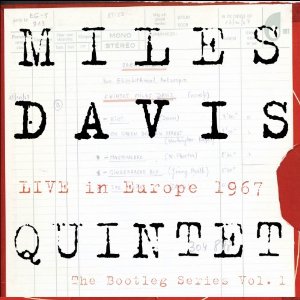
Columbia/Legacy
Live In Europe 1967: The Bootleg Series Vol. I captures the Miles Davis Quintet lineup circa ’65-’68, a time when their communal muse and ESP were at their heights. Think of it: Wayne Shorter on tenor sax; Herbie Hancock on piano; Ron Carter on bass; and a young-but-already-incredible (just 21 years old at the time) Tony Williams on drums – led by Davis, whose skills as a coach and conjurer were as important as his trumpet playing.
With John Coltrane only a few months in his grave, the jazz scene was still reeling when Davis and company headed to Europe in the fall of 1967, along with a caravan that included Thelonious Monk, Archie Shepp, and Gary Burton with their respective bands.
Davis was encouraging his players to push; to react; to interact. In the wrong hands, that level of talent and barely-contained power could have easily imploded in a flurry of egos; Davis, however, led them to a place of improvisational brilliance where the group mind guided the craft. The five shows represented here (three spread over three CDs; two more shot in black & white on a bonus DVD) are nothing short of amazing.
During this period, Davis was not only pushing the boundaries of the individual songs, but the sets, as well. Were the songs from 10/28/67 (Antwerp, Belgium) on Disc I to be written out in true DeadBase style, the list would read something like: “Agitation”>“Footprints”>“‘Round Midnight”>“No Blues”>“Riot”, “On Green Dolphin Street”>“Masqualero”, “Gingerbread Boy”>“The Theme” – and even the two breaks notated are barely the length of a draw of breath. Sometimes the segues are turn-on-a-dime change-ups of key and rhythm with Williams leading the charge; other times the jams are paths gradually cleared by various hands. Some nights the set-closing “The Theme” is only a little over a minute (or, in the case of 11/7/67 a mere 28 seconds), while the Paris show saw the tune stretch out over eight minutes of hard bop. The setlists vary only slightly from night to night, but the songs are totally at the mercy of the heads, hearts, and hands involved, with melodies simply serving as launchpads.
Considering that the sources for the music on Live In Europe 1967 were vintage TV and radio recordings, the sound quality is excellent, capturing the full dynamics of the quintet’s explorations. Davis would be heading in the direction of fusion and funk in the year ahead, but these shows from late ’67 are a time capsule of jazz music holding its ground during a period when the world around it was in flux. In Miles-speak, this is truly “the real shit.”
The release of these shows is great news for not only fans of Davis’ music, but for anyone with an appreciation of a tight group of musical formation flyers blessed with incredible improvisational skills.
And some even greater news? Note that this is Volume I.
Bring it on, Columbia/Legacy – bring it on.



No Comments comments associated with this post